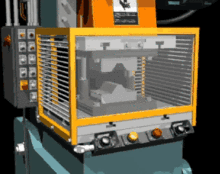Stamping press

A stamping press is a metalworking machine tool used to shape or cut metal by deforming it with a die. In simple terms, a stamping press is the modern day equivalent of a hammer and anvil. The only difference is that precision made male and female dies that dictate the shape of the finished part are between the hammer and anvil.
Components
A press has a bolster plate, and a ram.
Bolster Plate
The bolster plate is mounted on top of the press bed and is a large block of metal upon which the bottom portion of a die is clamped; the bolster plate is stationary. Large presses (like the ones used in the automotive industry) may be equipped die cushions integrated in the bolster plate to apply blank holder or counter draw forces. This is necessary when a single acting press is used for deep drawing. The ram / slide is the moving or reciprocating member that the upper die is mounted to. Ram or Slide guidance is a critical element to assure long die life between die maintenance. Different types of slide guides are available, 4 point V-Gibs or 6 point square gibs on smaller presses and 8 point full length slide guides on larger straight side frame presses. With the dies and material be fed into the die between the bolster and slide, good press designs must account for plastic deformation, other wise known as defection when frame design and loads are considered.
Ram / Slide
The vertical motion of the slide acts like a hammer to an anvil. When presses are used manually, where an operator is loading and unloading parts, extreme caution should be used and proper methods of safe guarding should be in place. With the addition of safety light curtains and an I-PRESS control, the light curtains can then be muted or turned off on the slide upstroke to increase productivity when press is being used in single stroke mode. Standard modes of operation with up to date safe press controls are OFF-INCH-SINGLE STROKE & CONTINUOUS modes which can be selected via a keyed mode selector switch. Special modes of operation include, MICRO INCH-SSD/SINGLE ON DEMAND & CSD/CONTINUOUS ON DEMAND. Micro Inch is normally used for die set up near the BDC / Bottom Dead Center, SSD Single Stroke on Demand can be used when long coil feed lengths or automation loading and unloading will trigger SSD. CSD Continuous on Demand is normally used when press are used in roll form lines or irregular stroking is required when punching holes in large panel with gag feed dies.
The most common Mechanical Presses use an eccentric drive to move the press's ram slide, length of stroke or slide travel depends on the crankshaft or eccentric, whereas hydraulic cylinders are used in hydraulic presses. The nature of drive system determines the force progression during the ram's stroke. Mechanical presses have a full tonnage rating point above BDC / Bottom Dead Center, normal full tonnage rating points are .187", .25" & .5". Hence a mechanical press has a tonnage curve and should be operated within the press capacity limits. Link Motion mechanical is yet another option, this provides a slide slow down near BDC / bottom dead center for soft touch tooling. This link feature can improve die life and reduce reverse-snap thru tonnage for blanking operations.
On the contrary, Hydraulic Presses do not have a tonnage curve and can produce full tonnage at any point in the stroke. The trade off is speed, a mechanical press is much faster when compared to hydraulic. On the other hand, Hydraulic Presses are much more practical for deep forming or drawing or parts or when dwell time at the bottom is desired. Another key feature with the I-PRESS AB PLUS HYDRO control, is that you can vary the speed, pressure and position up to 7 times on the downward stroke.
Another classification is single-acting presses versus double- (seldom triple) acting presses. Single-acting presses have one single ram. Double-acting presses have a subdivided ram, to manage, for example, blank holding (to avoid wrinkles) with one ram segment and the forming operation with the second ram segment.

Other Components & Controls
Typically, presses are electronically linked (with a programmable logic controller) to an automatic feeder which feeds metal raw material through the die. The raw material is fed into the automatic feeder after it has been unrolled from a coil and put through a straightener. A tonnage monitor may be provided to observe the amount of force used for each stroke.. Press and automation controls have take a huge leap forward in 2016 with safety, security, features & functions. A good example is Connected Enterprise with I-PRESS that allows users to log in from any remote device to and individual press. This allows for new job set ups to be downloaded from engineering or trouble shooting and operator assistance to be done from mobile devices or PC's.